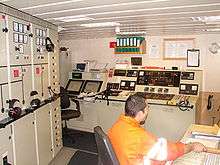Engineering officer (ship)

Ship (or marine) Engineering Officers or, simply, Ship Engineers are responsible for operating and maintaining the propulsion plants and support systems on board crew, passengers and cargo seafaring vessels[1] or other watercraft. Alternative terms commonly employed to collectively refer to the profession are seagoing or seafaring engineer officers. In the United States they are usually trained via cadet ships sponsored by a variety of maritime organizations. Engineering Officer Cadets of most countries are sponsored during training by a shipping company, serving their time on board ships owned by that company. Many go on to work as Engineering Officers with their sponsoring company once training is complete.
Ship engineers are responsible for propulsion and other ship systems such as: electrical power generation plant; lighting; fuel oil; lubrication; water distillation and separation; air conditioning; refrigeration; and water systems on board the vessel. They require knowledge and hands-on experience with electric power, electronics, pneumatics, hydraulics, chemistry, steam generation, gas turbines and even nuclear technology on certain military and civilian vessels.[1]
Ship Engineering Officers Ranks (typical for a British Merchant Vessel – US equivalents in italics):
- Chief Engineer: In charge of the engine department. Reports only to the Master. The Chief Engineer's training, responsibility and rank are all superior to those required for a Chief Officer.
- Second Engineer 1st Assistant Engineer: In charge of the day-to-day running of the engine department. Often in charge of main engine maintenance. Takes the 4–8 watch. He is the equivalent of the Chief Mate.
- Third Engineer 2nd Assistant Engineer: Usually in charge auxiliary engines & boilers. Takes the 12–4 watch.
- Fourth Engineer 3rd Assistant Engineer: Usually in charge of air compressors, purifiers, pumps and other auxiliary machinery. Takes the 8–12 watch. Sometimes in charge of boilers.
- Electro-technical Officer (ETO): Officer who is responsible for the maintenance of electrical and electronic equipment.
- Electrical Officer: Officer who is responsible for the maintenance of electrical equipment, but not electronic equipment such as radars, VHF etc.
- Junior Engineer: No official responsibilities - this rank is reserved for those who are qualified as Fourth Engineers but lack the experience necessary to take a watch.
- Cadet: A trainee officer. Understudies the other engine department personnel.
United States Navy ships have a varying number of engineering officers, depending upon the size of the crew, occupying positions named for subsidiary responsibilities of the Engineering Officer. The two highest ranking subordinates are usually the Main Propulsion Assistant (MPA), responsible for operation and maintenance of propulsion machinery, and the Damage Control Assistant (DCA), responsible for prevention and control of damage. Anticipation of battle damage increases the significance of responsibilities of the latter position on warships. A DCA often stands routine deck or engineering watches, but spends his off-watch time overseeing maintenance of watertight integrity and firefighting equipment. A DCA's battle station normally includes responsibility for controlling the ship's stability, list and trim by flooding and dewatering undamaged compartments as necessary to prevent capsizing. Additional engineering officers may include an Electrical Officer, responsible for the ship's electrical generating and distribution system as described above, and an Auxiliaries (or A Division) Officer, responsible for pumps, ventilation blowers, refrigeration compressors, and windlass machinery as described above for the Fourth Engineer.[2]
Typically, a ship's engine department is run by the Engineering Officers but manned with other occupational specialties of the seafarer's trade like:
- Machinist/Fitter: A rating (or petty officer) who is specialized in fabrication, welding, etc.
- Motorman: A qualified engine rating who stands a watch with the Engineer Officer, as well as performing menial tasks and assisting Engineering Officers during maintenance.
- Oiler: A rating who is responsible for ensuring that machinery is adequately lubricated. Performs menial tasks such as cleaning, sounding tanks etc.
- Wiper: The lowest rating in the engine room and is tasked with keeping the machinery spaces clean and tidy. Wipers usually go on to become oilers once they are familiar with engine room machinery and specific routines.
- Stoker: Now defunct, the stoker was an engine department rating with responsibility for shoveling coal into the boiler furnaces.
- Coal Trimmer: Now defunct, the coal trimmer was an engine department rating with responsibility to load coal in the bunkers and to transport the coal from the bunkers to the stokers
The oldest surviving marine engine was designed by William Symington in 1788. The ship 'Turbinia' first demonstrated the superiority of the steam-turbine engine, which is still used for marine propulsion today in some niche applications. In America, the University of Michigan's Department of Naval Architecture and Marine Engineering can be tracked to an 1879 act of Congress, which authorized the U.S. Navy to assign a few officers to engineering training establishments around the country. Mortimer E. Cooley was the first lecturer in the department.[3]
See also
- Engine department (ship)
- Engine room
- List of maritime colleges
- Marine engineering
- Marine fuel management
- Seafarer's professions and ranks
- Society of Naval Architects and Marine Engineers
References
- 1 2 Wise Geek: What is the Engine Department on a US Merchant Ship?
- ↑ "ENGINEERING ADMINISTRATION". Integrated Publishing. Retrieved 7 January 2014.
- ↑ "MDOT - Cooley, Mortimer E. (1855-1944)". michigan.gov.